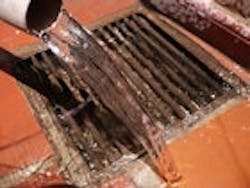EPA: New Report on Sewage Pollution in New York, New Jersey
When it rains, did you ever think about where all that rainwater is going? It flows down storm drains, carrying pollution from the streets, and if it is a heavy rain, causes sewage to overflow into rivers, lakes and streams.
Sewer overflows, especially from combined systems, are a major environmental problem. The U.S. Environmental Protection Agency (EPA) has prepared an important report, “Keeping Raw Sewage and Contaminated Stormwater Out of the Public’s Water,” to answer commonly asked questions about combined sewer overflows.
Many of the sewer systems in New York State and New Jersey and some in Puerto Rico are combined systems that carry sewage from homes and businesses as well as rainwater collected from street drains. When they overflow during heavy rains, the rainwater mixes with sewage and results in raw sewage being directly discharged into water bodies. These discharges are called combined sewer overflows and can pose serious environmental and public health risks.
The following is a sample of the information contained in the report:
Many communities have separate sewer systems for wastewater collection—an independent sewer system that carries sewage from buildings and another for rainwater, also referred to as storm water. The storm water is sent directly to lakes, rivers and streams, while domestic sewage is transported to wastewater treatment plants, where it is treated to remove pathogens and other contaminants.
Combined sewer systems, on the other hand, are designed to transport sewage, industrial wastewater and rainwater runoff in the same pipes to wastewater treatment plants. They are remnants of the country’s early infrastructure and are typically found in older cities.
Combined sewer systems serve about 40 million people in roughly 772 communities nationwide. Most communities with combined sewer systems are located in the Northeast and Great Lakes regions, and the Pacific Northwest. Most of the time, combined sewer systems are able to transport all of the wastewater to a treatment plant, where it is treated and then discharged into a water body.
During periods of heavy rainfall or snowmelt, however, the volume of wastewater traveling through a combined sewer system can exceed the capacity of the sewer system or treatment plant.
For this reason, combined sewer systems are designed to overflow occasionally and discharge excess wastewater directly to nearby streams, rivers, lakes or other water bodies. These overflows, called combined sewer overflows, contain not only storm water, but also pollutants such as untreated human and industrial waste, toxic materials and debris.
Storm water contains pollutants, including oil, grease and toxic substances, picked up as rain washes across roads or fields. These pathogens, solids and toxic pollutants may be discharged directly to local waters when it rains, resulting in a discharge that exceeds water quality standards. They pose risks to human health, threaten aquatic habitats and life, and impair the use and enjoyment of the nation’s waterways.
Under the federal Clean Water Act, combined sewer discharges are prohibited without a permit. In December 2000, Congress amended the act by adding a section that requires each permit issued for a discharge from a municipal combined sewer system to conform to a national combined sewer overflow policy.
The policy is a comprehensive national strategy to ensure that local governments, permitting agencies, entities that establish water quality standards and the public engage in a comprehensive and coordinated planning effort to achieve combined sewer overflow controls that ultimately meet health and environmental standards.
Source: EPA
